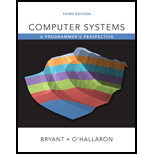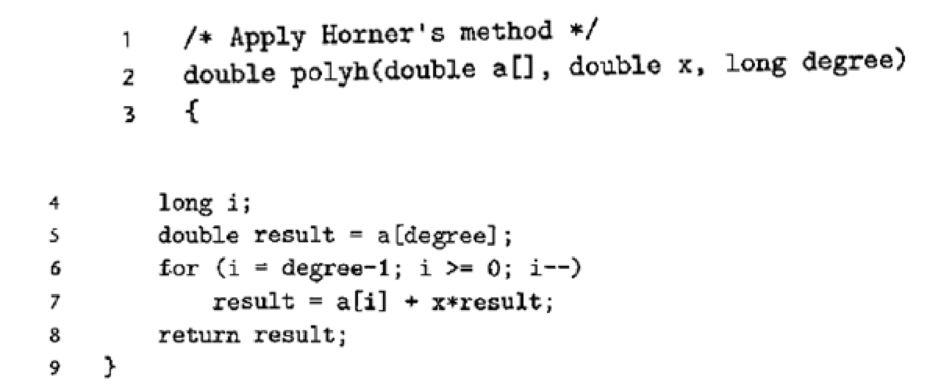
Practice Problem 5.6 (solution page 575)
Let us continue exploring ways to evaluate polynomials, as described in Practice Problem 5 5. We can reduce the number of multiplications in evaluating a polynomial by applying Horner’s method, named after British mathematician William G. Horner (1786-1837). The idea is to repeatedly factor out the powers of x to get the following evaluation:
a0+x(a1+x(a2+···x(an-1+xan)···)) (5.3)

Using Horner's method, we can implement polynomial evaluation using the following code:
- A. For degree n, how many additions and how many multiplications does this code perform?
- B. On our reference machine, with the arithmetic operations having the latencies shown in Figure 5.12, we measure the CPE for this function to be 8.00. Explain how this CPE arises based on the data dependencies formed between iterations due to the operations implementing line 7 of the function.
- C. Explain how the function shown in Practice Problem 5.5 can run faster, even though it requires more operations.
Want to see the full answer?
Check out a sample textbook solution
Chapter 5 Solutions
Computer Systems: A Programmer's Perspective Plus Mastering Engineering With Pearson Etext -- Access Card Package (3rd Edition)
Additional Engineering Textbook Solutions
Thinking Like an Engineer: An Active Learning Approach (4th Edition)
SURVEY OF OPERATING SYSTEMS
Concepts Of Programming Languages
INTERNATIONAL EDITION---Engineering Mechanics: Statics, 14th edition (SI unit)
Modern Database Management
Computer Science: An Overview (13th Edition) (What's New in Computer Science)
- show all the workarrow_forwardList down the strenghts and weaknesses of your team project for Capsim Simulation? Explan.arrow_forwardCapsim Team PowerPoint Presentations - Slide Title: Key LearningsWhat were the key learnings that you discovered as a team through your Capsim simulation?arrow_forward
- Write the SQL code that permits to implement the tables: Student and Transcript. NB: Add the constraints on the attributes – keys and other.arrow_forwardDraw an ERD that will involve the entity types: Professor, Student, Department and Course. Be sure to add relationship types, key attributes, attributes and multiplicity on the ERD.arrow_forwardDraw an ERD that represents a book in a library system. Be sure to add relationship types, key attributes, attributes and multiplicity on the ERD.arrow_forward
- 2:21 m Ο 21% AlmaNet WE ARE HIRING Experienced Freshers Salesforce Platform Developer APPLY NOW SEND YOUR CV: Email: hr.almanet@gmail.com Contact: +91 6264643660 Visit: www.almanet.in Locations: India, USA, UK, Vietnam (Remote & Hybrid Options Available)arrow_forwardProvide a detailed explanation of the architecture on the diagramarrow_forwardhello please explain the architecture in the diagram below. thanks youarrow_forward
 C++ for Engineers and ScientistsComputer ScienceISBN:9781133187844Author:Bronson, Gary J.Publisher:Course Technology Ptr
C++ for Engineers and ScientistsComputer ScienceISBN:9781133187844Author:Bronson, Gary J.Publisher:Course Technology Ptr C++ Programming: From Problem Analysis to Program...Computer ScienceISBN:9781337102087Author:D. S. MalikPublisher:Cengage Learning
C++ Programming: From Problem Analysis to Program...Computer ScienceISBN:9781337102087Author:D. S. MalikPublisher:Cengage Learning

